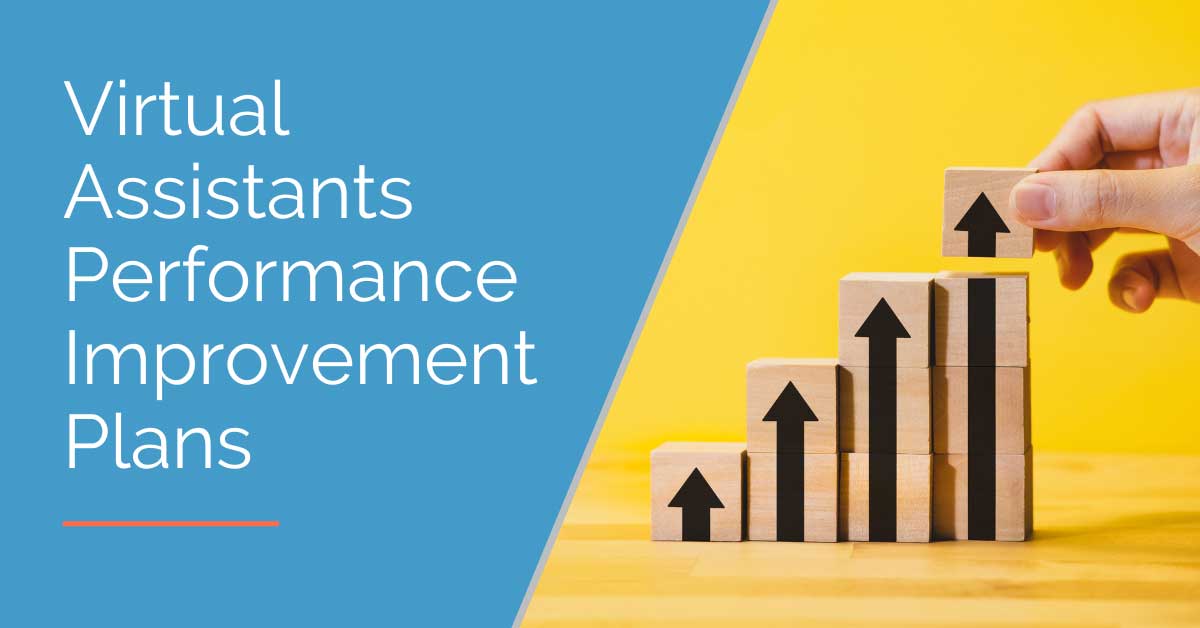Get Results with a Virtual Assistant Performance Plan
A virtual assistant performance plan is how you improve results with your remote team. Hiring and overseeing Virtual Assistants (VAs), also known as Remote Professionals, can present its own set of challenges, especially when they’re not physically present in your location.
Keeping up with their performance and offering helpful feedback can be a bit tricky.
That’s why discussing creating Performance Improvement Plans for VAs is valuable. Over time, it’s become clear that having a plan tailored to the VA’s particular needs can greatly boost its performance.

Why You Need a Virtual Assistant Performance Plan
Handling VAs can feel like a lot, especially if it’s new to you. So, we’ve put together an easy-to-understand guide to help you build a plan that works well for both you and your VAs.
In this blog post, we’ll walk you through creating a Performance Improvement Plan for your VAs, step by step. This guide should help you feel more comfortable managing your VAs and be useful in enhancing their performance.
Remember, overseeing VAs requires time and effort, but with the right strategy, you can guide your VAs to perform at their best and deliver the results your business needs.

Step 1: Identify the Problem
The first step in creating a performance improvement plan is to identify the problem. This can be a challenging task, particularly when working remotely.
However, it is crucial to take the time to understand the issue and what is causing it. You may need to speak with the VA to gain a better understanding of the problem and to identify any underlying issues that may be contributing to it.
Step 2: Set Specific Goals
Once you have identified the problem, the next step is to set specific goals for the VA. These goals should be measurable and achievable and should be aligned with the expectations you have set for them.
Be sure to communicate these goals clearly to your VA so that they understand what is expected of them.

Step 3: Develop a Plan
Once you have set specific goals, the next step is to develop a plan to achieve them. This plan should be specific to the VA and should include steps that they can take to improve their performance.
It may also include resources that they can use to help them improve, such as training materials or online courses.
Step 4: Monitor Progress
Monitoring progress is an essential part of any performance improvement plan. This involves regularly checking in with the VA to see how they are progressing towards their goals.
You may need to adjust the plan if progress is not being made, or if the plan is not working as intended.

Step 5: Provide Feedback
Feedback is a critical component of any performance improvement plan. It is essential to provide your VA with regular feedback on their performance, both positive and constructive.
This feedback should be specific, measurable, and actionable, and should be given in a timely manner.
Step 6: Evaluate Results of Your Virtual Assistants Performance Plan
Once the performance improvement plan has been implemented, it is important to evaluate the results. This involves assessing whether the VA has improved their performance and whether they have achieved the goals that were set for them.
If the plan has been successful, it may be necessary to create a new plan to continue to improve their performance. If the plan has not been successful, it may be necessary to explore other options, such as terminating their contract.
Creating a Performance Improvement Plan for your Virtual Assistants/Remote Professionals is a critical part of managing their performance, particularly when working remotely.
Running a team of virtual assistants (VAs) can be tough. It’s hard to check if they’re doing their best, and it’s not always easy to give them the help and feedback they need to get better.
But, there’s a way to make things better. Creating a special plan that fits the VA’s needs can really help improve how they work.

Final Thoughts on Virtual Assistant’s Performance
By following the six steps I’ve outlined in this blog post, you can create a plan that works for you and your VA, and help them improve their performance and meet your expectations.
Remember, managing VAs takes effort and patience, but it can also be incredibly rewarding. When you see them performing at their best and delivering the results you need, it’s a great feeling.
If you have any questions or need further assistance in creating a Performance Improvement Plan for your VA, feel free to reach out to me. I’m always here to help and share my experience with others who are managing Virtual Assistants.
Do you want to create an excellent customer service experience for your clients? Download your free customer performance improvement checklist to see incredible improvements and results HERE!
To get even more amazing tips, tricks, and techniques for scaling up your business, check out The Bootstrappers Podcast! Get the free advice you need to turn your vision into reality.





